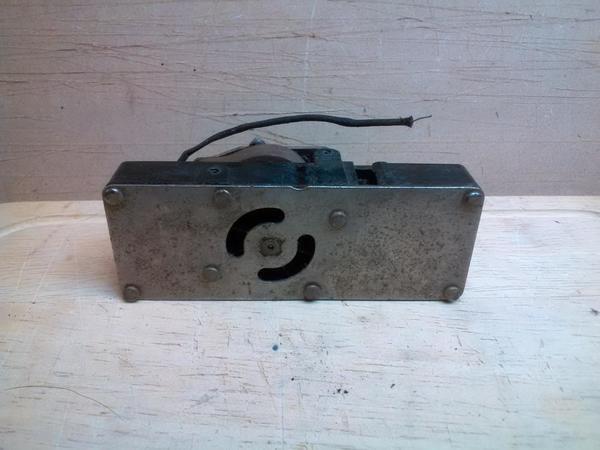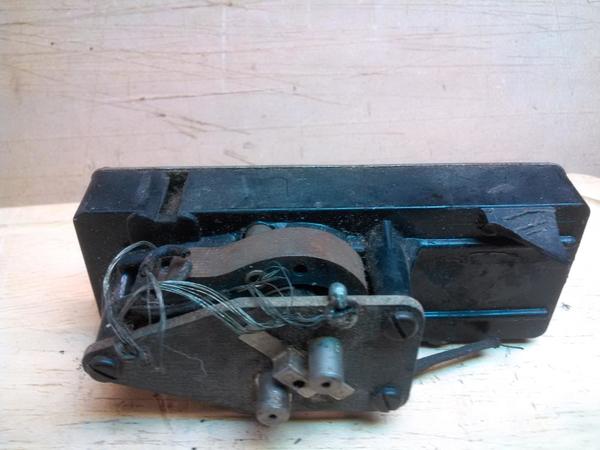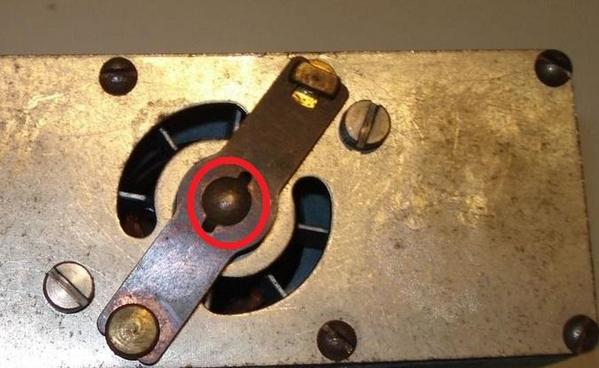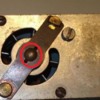I am pretty new to this forum and haven't yet found my way around or I would have just continued an earlier post on this subject. I finished the "gluing" part of the broken tab on the whistle relay on my #2689W tender, got it all cleaned, wired and tested. It works but it sounds like a duck in heat! Here is what I did to the tender. I securely glued and clamped the relay to the broken tab on the whistle relay. The relay was lined up to its exact position before the tab broke, whenever that was. I removed the brush plate and lubed the armature tail shaft, cleaned the armature field face sections, cleaned the, (OK), brushes and brush wells, replaced the cover and lubed the armature shaft. In both cases I used the lube, (Vaseline), sparingly. The truck pick-up rollers were cleaned and new wire soldered to both. The overall wiring is correct or I would have gotten a short when tested and/or the whistle wouldn't have sounded at all. Here is the test sequence. The whistle was silent, (no power), when the black throttle handle was advanced on the Lionel #1033. The whistle activated when I turned the orange whistle handle on the transformer. It sounded bad, (some whistle, some squealing like it needed lube and some rattling like I may have a bearing issue). I worked with it for a while and watched the contacts engage and disengage on the relay and they seemed to be functioning correctly. But when I released the orange handle on the transformer the whistle continued until I shut the black throttle handle to off. Does anyone have any suggestions for me or possibly a pre-war whistle for sale? Thanks, GR
Replies sorted oldest to newest
Did you lube this bearing?
Also, Vaseline is a terrible lubricant for this application... almost anything else would be better except WD-40 or 3-In-1.
Motor oils would be fine. Even better, Mobil 1(or other modern synthetic) in a syringe/needle oiler.
Once lubed, connect the transformer with test leads and hold the tender upside down so you don't have to run it through the whistle controller circuit to work the oil in to the bearing/bushing surfaces. Run it at varying speeds until you get a noticeable improvement, check/relube with fresh, and then track test.
Attachments
Couple of things come to mind:
*Sometimes the impeller is not correctly aligned on the shaft
*I seem to recall some tenders used a 7/64 ball bearing or possibly 1/8 at the impeller end of the armature - may be worth replacing, I think it the part numbers are 50-102 or WS-106/ 2333-54
*Some tenders have a larger ball shaped bearing housing may have worn with too much play (WS-7)
*Brush spring tension
*Clean commutators on armature
Hi folks thanks for the replies. I did the lube thing and ran the heck out of the whistle but it still sounds like a banshee!!! I am not sure how to separate the armature from the chamber. Is there a bearing at either the top side of the armature or the bottom side near the impeller as suggested and if so how do I remove the armature to get at the bearing?
Is the whistle like the one I pictured above?
Rob,
The whistle chamber is plastic and the back plate holding the impeller is metal which now leads me to believe that it is a "Frankenstein"! I cannot see how it was configured to fit on the plastic chamber itself. It does fit though! I don't know about air leaks. The studs holding the back metal plate to the plastic chamber have no tool marks whatsoever. How can the back plate be removed? Also, once removed is it possible to remove the armature? I have spent way too much time on this whistle but I still cannot figure out why it sounds like it does. The sound it makes is a "motor sound", a high pitched whine and the more juice put to it the higher sound it blares. Even thought the back plate is metal it does not look like the photo you sent. The difference is that it does not have that cross bar which holds the armature tail shaft in place and the back plate has studs holding it to the chamber and not screws. I am totally out of ideas! GR
The whistle chamber is plastic and the back plate holding the impeller is metal which now leads me to believe that it is a "Frankenstein"
If you mean that someone cobbled it together outside of the factory .... no.
Lionel made whistles that way for a while.
Unless the impeller (fan) is damaged, I am not certain what you might gain by removing the metal cover. You should be able to lubricate the bearing that is mounted on the metal plate by placing a drop of oil in the hole, which is covered by a ball bearing. Use the tip of your needlepoint oiler or some other small object to gently push the ball in a bit to encourage the oil to flow into the bearing.
Try blowing into the chamber where the fan is visible. Do you get a whistle sound?
If not you could have air leaks.
Another likely cause is stuff in the air chambers. Sometimes bugs like to build nests in them. Fortunately, the bugs are usually long gone by the time we train people come into possession of these trains. (have not had a live bug problem yet)
Based on your description, I wonder whether the problem is that your motor just isn't running fast enough to blow the whistle.
Those sheet metal tenders weren't designed to allow the whistle motor to be serviced. I have seen many whistles that were noisy, where the motor sounds were louder than the whistle sound. I have wondered whether the problem might be that the whistle was used too many times with dry bearing surfaces, and the bearing were just worn out.
The cover is held on by Drive pins. They don't come out that easily. The pins usually have twisted ribs on the body. So you have to twist the pins as they are removed. Also when they are re-inserted.
I have grabbed the edges of those pins with nippers to get them out. Twist and lift at the same time.
It isn't pretty. The nippers are going to leave marks.
C.W. Thanks you for your reply. The motor is running fast enough. Hot wiring the tender with the throttle open full really bleats out a nasty noise! The impeller is not damaged. I have looked closely at it with a flashlight while slowly turning it. I blew canned air into the impeller hole and there was a weak whistle. I pushed the bearing in while adding a drop of motor oil into the hole so I am certain that the shaft of the armature is well lubricated. I added new brushes and springs. I am beginning to think I am going to have to live with a crappy sounding whistle. Meanwhile I put the body back on the frame but did not twist the little tabs just in case I get a tip that I hadn't received previously. Thanks again for your suggestions. GR
Since we have a plastic body and leaning towards believeing we have a transplanted unit, can you identify the unit from here:
http://pictures.olsenstoy.com/searchcd31.htm?itm=1065
If so, order and replace the appropriate bearings.
Here are a couple of photographs of a plastic whistle housing with a metal cover. This particular whistle mechanism is damaged. The e-unit mounting bracket is broken off. It belongs to a late 2226WX tender that I am rebuilding for my brother.
The "lower" bearing is mounted to the metal plate. I don't think it is replaceable.
The "upper" bearing (closest to commutator) is just a hole made in the fiberboard brush plate. No metal bearing material.


If anybody has fixes for bad bearing on these whistles, I'd like to read about them.
Attachments
C.W. This looks exactly what I have including the broken relay tab! Please clear this up for me. The lower bearing sits at the end of the lower armature shaft? If that is the case could the metal back plate be removed, the armature pulled out and a new bearing put in? Is there a bearing that sits on the top of the armature shaft? GR
The broken relay bracket is a common problem on that version of the whistle.
As I wrote above, I don't think the bearing that is mounted on the metal plate is replaceable.
There is no bearing in the brush plate, just a hole.
IMHO, the problem is more likely to be a worn (enlarged) hole in the brush plate, as opposed to a worn lower bearing.
I've read that some folks have had success putting an eyelet in the hole in the brush plate. I never tried it, and I do not recall how the work was supposed to be done.
Replacement brush plates are fairly easy to find.
The bearing on discussion is replaceable and stocked as WS-106 and WS-107 from most parts places. Follow the Olsen's link I shared earlier to see exploded diagrams for replacement process.








